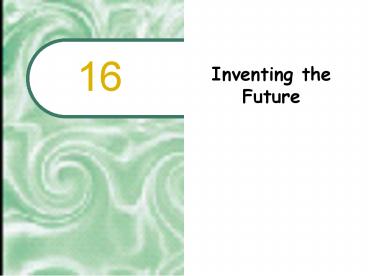Inventing the Future PowerPoint PPT Presentation
1 / 29
Title: Inventing the Future
1
16
- Inventing the Future
2
Chapter Outline
The best way to predict the future is to invent
it. Alan Kay
- Tomorrow Never Knows
- From Research to Reality 21st-Century
Information Technology - Human Questions for a Computer Age
3
Tomorrow Never Knows
- The hazards of predicting the future are that
technology is hard to foresee and the impact on
society is even harder to predict
4
Tomorrow Never Knows
Recognizing these four phases of technology is
one way to predict the future
- Hardware must begin with new hardware
- Software software gives value to hardware
products - Service hardware/software must serve a human
need - Way of Life the service must become a way of
life
5
From Research to Reality
- Engineers and scientists are shaping the future
of computers and information technology - Which ideas will actually bear fruit can be
speculated based on current trends
6
Tomorrows Hardware Trends
- Trends in computer hardware include
- Speed todays computers process millions of
instructions per second (MIPS) - Size no longer room-sized, todays computers
can fit in your hand - Efficiency todays computers consume less
electricity than their precursors
7
Tomorrows Hardware Trends
- Trends in computer hardware include
- Capacity data storage is no longer a constraint
- Cost todays computers cost only a fraction of
the earlier machines
8
Tomorrows Hardware Innovations
New technological advancements have led to many
hardware innovations
- Alternative chip technologies
- Alternative storage technologies
- Alternative output displays
- Alternative input devices
- System on a chip
- Parallel processing
- 64-bit processors
9
Tomorrows SoftwareEvolving Applications
Interfaces
- Software technologycontinues to evolve
- Examples of advancesin software include
- WIMP (windows, icons, menus, pointing devices)
- SILK (speech, image, language, knowledge)
10
Tomorrows SoftwareEvolving Interfaces
- Todays WIMP interface may be replaced by
tomorrows SILK interface - Speech and Language speech technology will
become part of the user interface - Image two-dimensional interfaces will give rise
to three-dimensional interfaces and include
virtual reality - Knowledge intelligent applications will make
interfaces more friendly, forgiving, and useful
11
Tomorrows ServiceTruly Intelligent Agents
- Intelligent agents are programs designed to be
managed rather than manipulated - Example PC applications use Wizards to guide
users through complex tasks
12
Tomorrows ServiceTruly Intelligent Agents
- Todays intelligent agents can
- Ask questions
- Respond to commands
- Pay attention to the users work patterns
- Serve as a guide and coach
- Take on the users goals
- Use reasoning to fabricate its own goals
13
Tomorrows ServiceTruly Intelligent Agents
- The Internet is home to bots software robots
that
- crawl around the Web collecting information
- help consumers make decisions
- answer e-mail
- play games
14
Tomorrows ServiceTruly Intelligent Agents
Tomorrows agents may
- Remind you to maintenance your car
- Assist in tracking communications within a study
or work group - Teach you new software
- Protect your privacy and keep your system and
residence safe - Possess a degree of sensitivity
15
Tomorrows Way of LifeTransparent Technology
This will be the generation where the
technology disappears into the tool, serving
valuable functions but keeping out of the way
the generation of the invisible computer. Donald
A. Norman
16
Embedded Intelligence
- Information appliances hide the technological
details - Cell phones, fax machines, GPS devices, household
appliances, and automobiles process information
invisibly
17
Ubiquitous Computers
Three sizes of ubiquitous computers are being
developed, in the form of
- Tabs like smart badges
- Pads like smart notebooks and books
- Boards like smart bulletin boards and
blackboards
18
From Internet to Omninet
The Net will evolve into a tightly woven,
seamless fabric.
- Attempts are being made to make computing as
plentiful as the air we breathe.
19
The Day After Tomorrow Information Technology
Meets Biology
The information age wont last forever
- In the future, biotechnology and microtechnology
will become more intertwined with computer
technology - These possibilities have led to developments in
- Microtechnology
- Nanotechnology
- Artificial Life
20
Borrowing from Biology
The network of today is engineered, and the
network of 2050 is grown. Paul Saffo
- The network of the future may be more like a
biological system - Individual computers learn from experience
- Genetic algorithms evolve through many generations
21
Microtechnology
- Microtechnology is the development of microscopic
machines on the scale of a millionth of a meter
22
Microtechnology
- Microsensors are used to detect pressure,
temperature, and other environmental qualities - They are used in cars, planes, and spacecraft
- In the future, they might be used to detect and
destroy cancer cells
23
Nanotechnology
- Nanotechnology is the building of machines, atom
by atom - Nanomachines are only a few billionths of a
meter in size
24
Nanotechnology
- Nanomachines have been built that use the motion
of a single atom as a switch - Nanomachines are being used to unlock the
secrets of genetics - Germ-sized robots might be built in the future
25
Artificial Life
- Artificial life includes synthetic organisms that
act like natural living systems - Some experts create simple software organisms
that exist in computer memory
26
Artificial Life
- Other experts build colonies of insect robots
that communicate with each other and respond to
changes in the environment - In the future, the line of distinction between
artificial and real life may disappear
27
Human Questionsfor a Computer Age
- Will computers be democratic?
- Will the global village be a community?
- Will we become information slaves?
28
Standing on the Shoulders of Giants
If I have seen farther than other men, it is
because I stood on the shoulders of
giants. Isaac Newton
- The computer can be used to empower or
imprisonto explore or exploitto create or
destroywe can chooseto invent the future.
29
(No Transcript)

